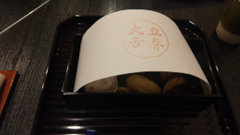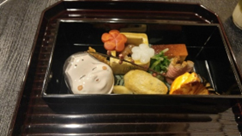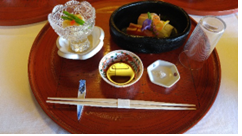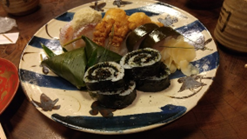Celebration and Kyoto cuisine registered as an intangible cultural property VOL.1
(1) The ultimate in Kyoto culture is Kyoto cuisine
Yoshie Doi

A dish of Daikichi’s Risshun Daikichi dish |

A dish that opens the covered paper |

Appetizer |

Kyoto Sushi Platter |
In March 2009, I wrote an article titled “Kyoto’s food culture is the ultimate Kyoto culture” in the report of the Tourism Research Institute of Osaka University of Tourism. At that time, a government official who had read my paper advised me to act to have Kyoto cuisine registered as a World Heritage Site. As someone who was born and raised in Kyoto, I was very grateful for his advice.
So, I appealed to the people who would be key persons, but I remember that nothing was done at all. I am deeply grateful and moved by this move to register as an intangible cultural property.
The culture of Kyoto has become one with the nature of the four seasons, accepting the workings of nature, and events and festivals have taken root in our lives. I believe that the origin of food culture is still alive in Kyoto because the base layer of this culture is thick. In particular, people in Kyoto City are watching the mountains 365 days a year, watching the colors of the seasons and how they change with the time of day. It is because of this kind of environment that they are sensitive to the changes in color and nature.
This environment is also the origin of Kyoto cuisine. Famous water springs out, seasonal Kyoto vegetables, miso, soy sauce, vinegar and other seasonings are abundant. Kyoto cuisine is to be enjoyed with all five senses, choosing tableware and serving dishes in consideration of comfort, eating with eyes, eating with colors, enjoying aromas, and enjoying with five senses.
As an aside, when I got married, my future husband took me to Japanese style restaurants, haute cuisine restaurants, and teahouses in Gion, saying, “I want you to study the relationship between presentation and tableware.” Therefore, what I learned for my own way of life is still useful.
I feel that Kyoto is the epitome of “subtractive aesthetics.” We bring out the ingredients of carefully grown ingredients and finish them with as few seasonings and cooking methods as possible. Taking advantage of the goodness of seasonal ingredients, it is served in a small bowl. Unlike Western cuisine, it is a dish that brings out the flavor of the ingredients.
Pike conger, which in other regions is discarded after removing the broth, is also a fine dish in Kyoto. It is said that cutting a bony pike conger 26 times into one inch (3cm) is a good way to cut the pike conger. It is customary to eat pike conger during the Gion Festival.
For 20 years, I have been in charge of a course called “Kyoto Shokumonogatari” and have conducted fieldwork in many food settings. In particular, the caterer I met there is a male-only occupation that exists only in Kyoto, and is a general producer of banquets and tea ceremonies. These are the important people behind the scenes.
By the way, the things that only exist in Kyoto are senmaizuke blades and senmaizuke vinegar. Only in Kyoto. When proprietresses of ryokan inns and restaurants all over the country came to Kyoto, she said she wanted to buy this blade for senmaizuke pickles, and I have used to guide her to a store.
When the proprietress of a Japanese restaurant in Kyoto welcomes guests, she bows to make her body look as small as possible. This is also Kyoto style hospitality!
The end of document
